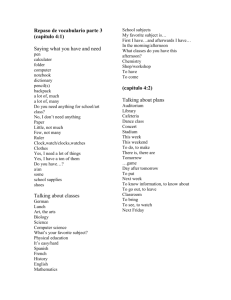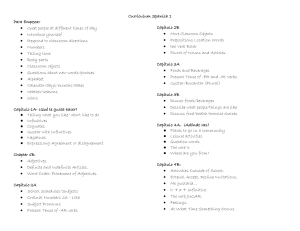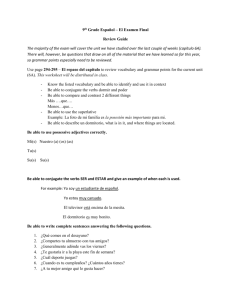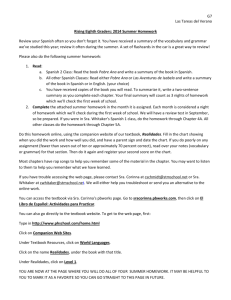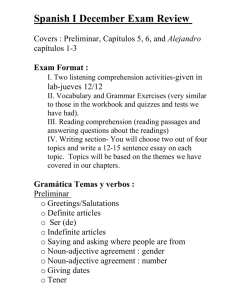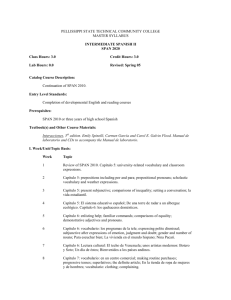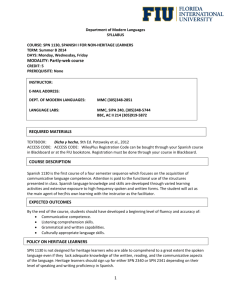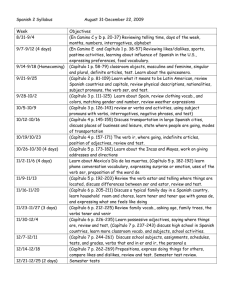Instructors may have pop quizzes during the
advertisement
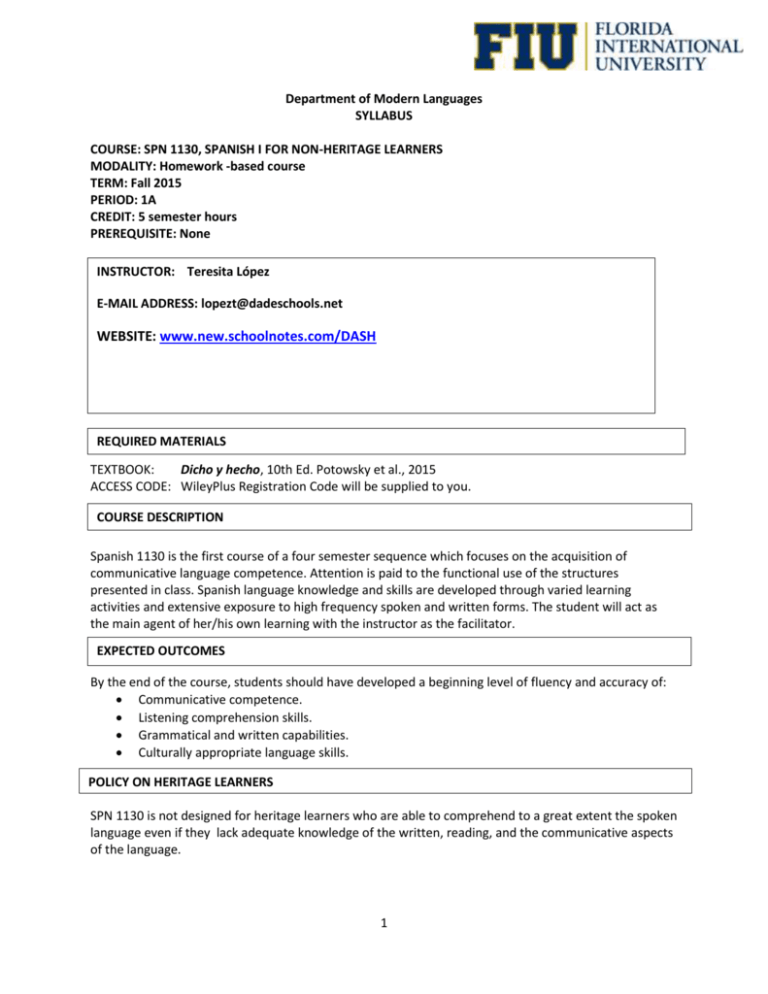
Department of Modern Languages SYLLABUS COURSE: SPN 1130, SPANISH I FOR NON-HERITAGE LEARNERS MODALITY: Homework -based course TERM: Fall 2015 PERIOD: 1A CREDIT: 5 semester hours PREREQUISITE: None INSTRUCTOR: Teresita López E-MAIL ADDRESS: lopezt@dadeschools.net WEBSITE: www.new.schoolnotes.com/DASH REQUIRED MATERIALS TEXTBOOK: Dicho y hecho, 10th Ed. Potowsky et al., 2015 ACCESS CODE: WileyPlus Registration Code will be supplied to you. COURSE DESCRIPTION Spanish 1130 is the first course of a four semester sequence which focuses on the acquisition of communicative language competence. Attention is paid to the functional use of the structures presented in class. Spanish language knowledge and skills are developed through varied learning activities and extensive exposure to high frequency spoken and written forms. The student will act as the main agent of her/his own learning with the instructor as the facilitator. EXPECTED OUTCOMES By the end of the course, students should have developed a beginning level of fluency and accuracy of: Communicative competence. Listening comprehension skills. Grammatical and written capabilities. Culturally appropriate language skills. POLICY ON HERITAGE LEARNERS SPN 1130 is not designed for heritage learners who are able to comprehend to a great extent the spoken language even if they lack adequate knowledge of the written, reading, and the communicative aspects of the language. 1 COURSE EVALUATION PARTICIPATION WILEYPLUS HOMEWORK PARTIAL EXAMS (2) COMPOSITIONS (3) VIDEO PROJECT ORAL EXAM FINAL EXAM 15% 20% 15% 10% 10% 10 % 20% GRADE SCALE (This scale will be used to enter your grade at FIU) A AB+ B BC+ 100-93.0 92.9-90.0 89.9-88.0 87.9-83.0 82.9-80.0 79.9-78.0 C CD+ D DF 77.9-73.0 72.9-70.0 69.9-68.0 67.9-63.0 62.9-60.0 59.9-BELOW A STUDENT WHO RECEIVES A GRADE OF “C-“, OR LESS, IN THIS COURSE, OR A “C” IN ANY DASH COURSE, WILL BE DROPPED FROM FIU’S DUAL ENROLLMENT PROGRAM GRADE SCALE (This scale will be used to enter your grade at DASH) A 100-90 B 89-80 C 79-70 D 69-60 F 59-BELOW ATTENDANCE: Students are expected to attend class regularly and to come to class prepared and ready to participate actively. Tardiness is disruptive to the class; therefore, students should be on time for class. A student will automatically receive a grade of F as the final grade for the course if the student is absent from 40% (or more) of the total number of classes for the semester. NOTE: In order to maintain an environment conducive to learning, students are asked to turn off or silence Smart phones, Ipods and all electronic devices before entering the classroom. 2 PARTICIPATION (15%) Each week, your instructor will evaluate your participation level and you will have the opportunity to earn 5 points for every class if you speak in Spanish during the whole class and in group discussions and participate in all activities with enthusiasm and a positive attitude. HOMEWORK (20%): Students are responsible for reading, prior to class, the textbook pages containing the explanations of the grammatical points to be used and practiced during the in-class activities. Students will complete the homework exercises (listening, reading, grammar) on Blackboard/WileyPlus, by the due date. Regular homework assignments will appear on www.newschoolnotes.com/DASH/ PARTIAL EXAMS (15%): There will be two in-class partial exams. The PE 1 will cover chapters 1, 2 and the PE 2 will cover 3, 4. These exams will consist of the following sections: listening comprehension, vocabulary, grammar, writing, and culture. The dates of the exams are indicated in the course calendar below. No make-ups will be given without a documented and valid reason. COMPOSITIONS (10%): You will be required to write in class a total of 3 compositions in Spanish on a topic assigned by your instructor on the date indicated by him/her. VIDEO PROJECT (10%): Each group (of 3 or 4) will do a video for 2 or 3 min. in Spanish about a topic such as Hispanic food, Hispanic customs and traditions or other related topics with instructor’s permission. Topics may, for example, include autobiographical speeches, your university life or how-to demonstrations. Students should come up with creative ideas that maintain the audience’s attention. Videos will be shown in class. Your instructor will provide you with more information on the project. ORAL EXAM (10%): The exam will take place during class time the week before the end of this semester course. The exam will consist of a communicative activity with another classmate in front of your instructor. You will not be able to have any notes. You will be graded on your fluency, your grammatical accuracy and your breadth of vocabulary. No make-ups will be given without a documented and valid reason. FINAL EXAM (20%): The final exam will be comprehensive and will be given in class at the end of the semester (Second Grading Period). No make-ups will be given without a documented and valid reason. Instructors may have pop quizzes during the semester as deemed necessary. STUDENT RESPONSIBILITIES INCOMPLETE GRADE: A grade of “I” is only given when there is a valid, documented reason, which prevents the student from completing the course. A student should have completed at least 60% of the course work in order to get an Incomplete grade. If such reason arises, please advise your instructor immediately, and make arrangements for removing the Incomplete as soon as possible. ACADEMIC DISHONESTY: All course work must be the work of the student; otherwise, it is considered cheating. Plagiarism, cheating, and forgery are serious offenses and will not be tolerated as stated in the Academic Misconduct section of FIU’s Academic Affairs Policies, Manuals, and Handbooks. STUDENTS WITH DISABILITY: Accommodations will be provided as per Miami Dade Public School’s Individual Education Plan (IEP). 3 COURSE CALENDAR WEEK 1 Introduction to the course, enroll in WileyPlus. Capítulo 1: Nuevos encuentros Lesson goals: Introducing oneself and others, greetings and goodbyes. Las presentaciones, pp. 2-3 Capítulo 1: Nuevos encuentros Lesson goals: Introducing oneself and others, greetings and goodbyes. Las presentaciones, saludos y despedidas, expresiones de cortesía, pp. 4, 8 Cultura: Greetings, p. 7 Capítulo 1: Nuevos encuentros Lesson goals: Identify and describe people. Subject pronouns and the verb SER, p. 9 Describing with adjectives, p. 10 WEEK 2 Capítulo 1: Nuevos encuentros Lesson goals: Learning the letters of the alphabet. El alfabeto, p.15 Capítulo 1: Nuevos encuentros Lesson goals: Using numbers Los números del 0 al 99, p. 13 Capítulo 1: Nuevos encuentros Lesson goals: Learning the days of the week and the months of the year. Los días de la semana, los meses del año, los cumpleaños, pp. 16, 18, 20 WEEK 3 LABOR DAY. NO CLASS. Capítulo 1: Nuevos encuentros Lesson goals: Tell time. Hispanic nationalities. Decir la hora, p. 21 El español en el mundo hispano, p. 25 Capítulo 1: Nuevos encuentros Lesson goals: Lesson goals: Communicative and/or cultural activities 4 WEEK 4 Capítulo 2: La vida universitaria Lesson goals: Identifying objects and persons, gender and number: Nouns and articles La vida universitaria, pp. 30-31 Género y número, artículos, pp. 33-34 Capítulo 2: La vida universitaria Lesson goals: Learning about the academic life. Talking about going places. Las clases universitarias y el campus, p. 36 Ir + a + destination, p. 40 Capítulo 2: La vida universitaria Lesson goals: Cultura: Puerto Rico Lectura p. 45 WEEK 5 Capítulo 2: La vida universitaria Lesson goals: Talking about actions in the present. Verbos regulares en – ar, p. 46 Capítulo 2: La vida universitaria Lesson goals: Talking about actions in the present. Verbos regulares en – er and - ir, p. 50 Cultura: La vida universitaria en el mundo hispano p. 48 Capítulo 2: La vida universitaria Lesson goals: Communicative and/or cultural activities WEEK 6 Partial Exam 1. It will cover chapters 1 and 2. Capítulo 3: Así es mi familia Lesson goals: Talking about the family. Así es mi familia, pp. 60-62, 64 Capítulo 3: Así es mi familia Lesson goals: Indicating possession with the verb TENER and telling one’s age. Tener y tener...años, p. 65 Cultura: La familia hispana, p. 73 Capítulo 3: Así es mi familia 5 Lesson goals: Cultura. Los hispanos en Estados Unidos. Lectura p. 67 WEEK 7 Capítulo 3: Así es mi familia Lesson goals: Describing people and things. Adjetivos descriptivos con SER, p. 69 Capítulo 3: Así es mi familia Lesson goals: Indicating possession. Adjetivos posesivos y el uso de “de”, p.74 Para conversar p. 82 Capítulo 3: Así es mi familia Lesson goals: Indicating location of people, places, and things. Describing conditions. El verbo ESTAR, p. 77 Adjetivos con ESTAR, p. 79 WEEK 8 Capítulo 4: ¡A la mesa! Lesson goals: Talking about food. ¡A la mesa!, pp. 88-89 Capítulo 4: ¡A la mesa! Lesson goals: Expressing likes and dislikes. El verbo GUSTAR, pp. 93-94 Capítulo 4: ¡A la mesa! Lesson goals: Cultura. México Lectura p. 97 WEEK 9 Capítulo 4: ¡A la mesa! Lesson goals: Meals and drinks. Las comidas y las bebidas, pp. 99-100 En el restaurante, p. 105. Capítulo 4: ¡A la mesa! Lesson goals: Talking about actions, desires, and preferences. Verbos irregulares, p. 102 Las comidas en el mundo hispano. p. 106 6 Capítulo 4: ¡A la mesa! Lesson goals: Counting from 100 and indicating the year. Los números a partir de 100 y el año, p. 107 WEEK 10 Capítulo 4: ¡A la mesa! Lesson goals: Asking for specific information. Palabras interrogativas, p. 111 Capítulo 4: ¡A la mesa! Para conversar ¿Qué comemos? p. 115 VideoEscenas, p. 110 Capítulo 4: ¡A la mesa! Lesson goals: Communicative and/or cultural activities WEEK 11 Partial Exam 2 (in class). It will cover chapters 3 and 4. Capítulo 5: Nuestro tiempo libre Lesson goals: Talk about hobbies, pastimes, and activities. Nuestro tiempo libre, ¿activos o sedentarios?, pp. 122-123 Capítulo 5: Nuestro tiempo libre Lesson goals: Talking about activities in the present. Verbos irregulares en YO: SABER/ CONOCER, P. 131 Otros verbos irregulares, p. 134 Cultura. Cuba y la República Dominicana Lectura p. 130 WEEK 12 Capítulo 5: Nuestro tiempo libre Lesson goals: Expressing preferences, obligations, and intentions. Expresiones: Tener ganas de+infinitivo…tener que+infinitivo…pensar+infinitivo…, p. 137 VETERANS DAY HOLIDAY Capítulo 5: Nuestro tiempo libre Lesson goals: Making future plans. 7 Ir + a + infinitivo, p. 139 VideoEscenas, p. 141 WEEK 13 Capítulo 5: Nuestro tiempo libre Lesson goals: Learning about the weather and the seasons. ¿Qué tiempo hace?, p. 142 Capítulo 5: Nuestro tiempo libre Lesson goals: Emphasizing that an action is in progress. Presente progresivo, p. 146 Cultura: El fútbol, el rey de los deportes p. 145 Capítulo 5: Nuestro tiempo libre Lesson goals: Describing people, places, and things. Los verbos SER y ESTAR (resumen), p. 148 WEEK 14 Nuestro tiempo libre Lesson goals: Communicative and/or cultural activities Review for Final Exam THANKSGIVING HOLIDAY WEEK 15 ORAL EXAM WEEK WEEK 16 FINAL EXAM WEEK SUMMARY OF DEADLINES All activities are due by 11:00 PM EST on the dates indicated or you will receive an “F” for each WileyPlus Homework missed. WILEYPLUS HOMEWORK: Lesson 1: SEPT. 13 Lesson 2: SEPT. 27 8 Lesson 3: OCT. 11 Lesson 4: NOV. 1 Lesson 5: NOV. 25 IN-CLASS PARTIAL EXAMS: Partial Exam 1: SEPTEMBER Partial Exam 2: NOVEMBER 9
